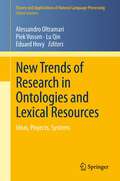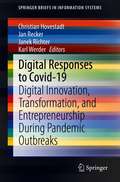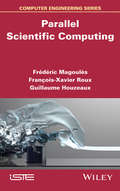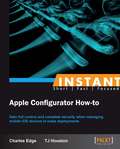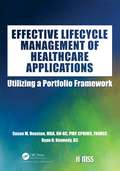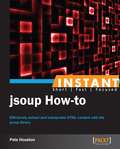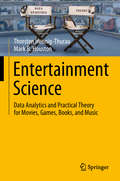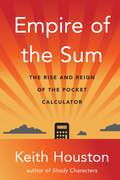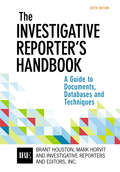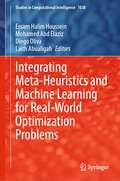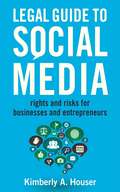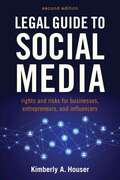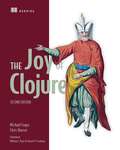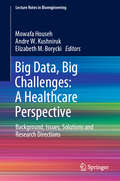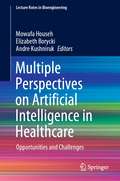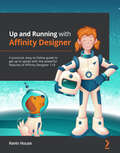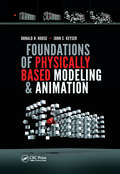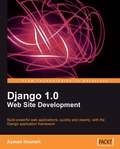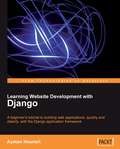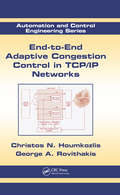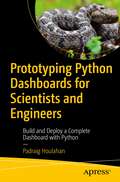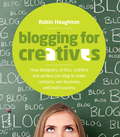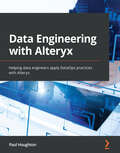- Table View
- List View
New Trends of Research in Ontologies and Lexical Resources
by Eduard Hovy Alessandro Oltramari Piek Vossen Lu QinIn order to exchange knowledge, humans need to share a common lexicon of words as well as to access the world models underlying that lexicon. What is a natural process for a human turns out to be an extremely hard task for a machine: computers can't represent knowledge as effectively as humans do, which hampers, for example, meaning disambiguation and communication. Applied ontologies and NLP have been developed to face these challenges. Integrating ontologies with (possibly multilingual) lexical resources is an essential requirement to make human language understandable by machines, and also to enable interoperability and computability across information systems and, ultimately, in the Web. This book explores recent advances in the integration of ontologies and lexical resources, including questions such as building the required infrastructure (e.g., the Semantic Web) and different formalisms, methods and platforms for eliciting, analyzing and encoding knowledge contents (e.g., multimedia, emotions, events, etc.). The contributors look towards next-generation technologies, shifting the focus from the state of the art to the future of Ontologies and Lexical Resources. This work will be of interest to research scientists, graduate students, and professionals in the fields of knowledge engineering, computational linguistics, and semantic technologies.
Digital Responses to Covid-19: Digital Innovation, Transformation, and Entrepreneurship During Pandemic Outbreaks (SpringerBriefs in Information Systems)
by Christian Hovestadt Jan Recker Janek Richter Karl WerderThis book presents ten essays that examine the potential of digital responses to the COVID-19 pandemic. The essays explore new digital concepts for learning and teaching, provide an overview of organizational responses to the crisis through digital technologies, and examine digital solutions developed to manage the crisis. Scientists from many disciplines work together in the fight against the virus and its numerous consequences. This book explores how information systems researchers can contribute to these global efforts. The book will be of interest to researchers and scholars in the field of digital business and education.
Parallel Scientific Computing
by Guillaume Houzeaux François-Xavier Roux Frédéric MagoulesScientific computing has become an indispensable tool in numerous fields, such as physics, mechanics, biology,finance and industry. For example, it enables us, thanks to efficient algorithms adapted to current computers, tosimulate, without the help of models or experimentations, the deflection of beams in bending, the sound level in a theater room or a fluid flowing around an aircraft wing.This book presents the scientific computing techniques applied to parallel computing for the numerical simulation of large-scale problems; these problems result from systems modeled by partial differential equations. Computing concepts will be tackled via examples.Implementation and programming techniques resulting from the finite element method will be presented for direct solvers, iterative solvers and domain decomposition methods, along with an introduction to MPI and OpenMP.
Instant Apple iOS Configuration Utility How-to
by Tj Houston Charles EdgeFilled with practical, step-by-step instructions and clear explanations for the most important and useful tasks. Get the job done and learn as you go. A how-To book with practical recipes accompanied with rich screenshots for easy comprehension.This book follows the Packt How-to approach, offering an informative yet practical guide that is easy to understand. The book takes a meticulous approach to providing quick and simple recipe-based solutions for security and deployment of iOS devices."Instant Apple iOS Configurator Utility How-to" book is ideal for anyone with a working knowledge in iOS device deployment and management. It is likely you will be responsible for the maintenance and security of iOS devices, ranging anywhere from 10 to 10,000. This is the ultimate guide to iOS security management and device deployment.
Effective Lifecycle Management of Healthcare Applications: Utilizing a Portfolio Framework (HIMSS Book Series)
by Susan M. Houston Ryan D. KennedyThe rapid growth of software applications within healthcare organizations has made it essential to have defined methodologies and formal processes for the management of the entire Information Technology (IT) portfolio. Utilizing a portfolio management framework throughout an application’s lifecycle will provide the necessary structure to ensure that all new applications are properly evaluated, and, once implemented, remain relevant while continuing to meet organizational requirements. While an organization may have a few large "organization-wide" systems such as the Electronic Health Record (EHR), lab or radiology systems, they also have a large quantity of other clinical, administrative, and research systems. Some larger organizations now have hundreds of software applications to support and manage. The IT staff must be able to implement new requests while still maintaining the current application portfolio. Utilizing a standard repeatable process will help to manage these large portfolios of software applications. This book reviews the management of applications throughout their lifecycle, from initial request through disposition. Best practices dictate that every newly requested application undergoes analysis followed by an approval decision from the organization’s governance committee. The initial implementation project must include activities to prepare for ongoing support while ensuring the application is compliant with all security, privacy, and architecture requirements. An application spends years in operations and maintenance where changes occur regularly through configuration and release management, or additional projects. The cycle continues until disposition. Understanding when to dispose of an application is just as important as deciding when to implement a new one. A defined process for disposing of an application ensures all parts are properly removed or destroyed.
Instant jsoup How-to
by Pete HoustonFilled with practical, step-by-step instructions and clear explanations for the most important and useful tasks. This book will take a how-to approach, focusing on recipes that demonstrate Jsoup.If you are working in data scraping, data crawling, or within a similar area using Java, then this book is the one for you. This book acts as a fast-paced and simple guide to enhance your HTML data manipulating skills using one of the most well-known libraries, Jsoup.
Entertainment Science: Data Analytics And Practical Theory For Movies, Games, Books, And Music
by Mark B. Houston Thorsten Hennig-ThurauThe entertainment industry has long been dominated by legendary screenwriter William Goldman’s “Nobody-Knows-Anything” mantra, which argues that success is the result of managerial intuition and instinct. This book builds the case that combining such intuition with data analytics and rigorous scholarly knowledge provides a source of sustainable competitive advantage – the same recipe for success that is behind the rise of firms such as Netflix and Spotify, but has also fueled Disney’s recent success. Unlocking a large repertoire of scientific studies by business scholars and entertainment economists, the authors identify essential factors, mechanisms, and methods that help a new entertainment product succeed. The book thus offers a timely alternative to “Nobody-Knows” decision-making in the digital era: while coupling a good idea with smart data analytics and entertainment theory cannot guarantee a hit, it systematically and substantially increases the probability of success in the entertainment industry. Entertainment Science is poised to inspire fresh new thinking among managers, students of entertainment, and scholars alike.Thorsten Hennig-Thurau and Mark B. Houston – two of our finest scholars in the area of entertainment marketing – have produced a definitive research-based compendium that cuts across various branches of the arts to explain the phenomena that provide consumption experiences to capture the hearts and minds of audiences.Morris B. Holbrook, W. T. Dillard Professor Emeritus of Marketing, Columbia UniversityEntertainment Science is a must-read for everyone working in the entertainment industry today, where the impact of digital and the use of big data can’t be ignored anymore. Hennig-Thurau and Houston are the scientific frontrunners of knowledge that the industry urgently needs.Michael Kölmel, media entrepreneur and Honorary Professor of Media Economics at University of LeipzigEntertainment Science’s winning combination of creativity, theory, and data analytics offers managers in the creative industries and beyond a novel, compelling, and comprehensive approach to support their decision-making. This ground-breaking book marks the dawn of a new Golden Age of fruitful conversation between entertainment scholars, managers, and artists.Allègre Hadida, Associate Professor in Strategy, University of Cambridge
Empire of the Sum: The Rise And Reign Of The Pocket Calculator
by Keith HoustonThe hidden history of the pocket calculator—a device that ushered in modern mathematics, helped build the atomic bomb, and went with us to the moon—and the mathematicians, designers, and inventors who brought it to life. Starting with hands, abacus, and slide rule, humans have always reached for tools to simplify math. Pocket-sized calculators ushered in modern mathematics, helped build the atomic bomb, took us to the bottom of the ocean, and accompanied us to the moon. The pocket calculator changed our world, until it was supplanted by more modern devices that, in a cruel twist of irony, it helped to create. The calculator is dead; long live the calculator. In this witty mathematic and social history, Keith Houston transports readers from the nascent economies of the ancient world to World War II, where a Jewish engineer calculated for his life at Buchenwald, and into the technological arms race that led to the first affordable electronic pocket calculators. At every turn, Houston is a scholarly, affable guide to this global history of invention. Empire of the Sum will appeal to math lovers, history buffs, and anyone seeking to understand our trajectory to the computer age.
The Investigative Reporter’s Handbook: A Guide To Documents, Databases, And Techniques
by Brant Houston Mark Horvit Investigative Reporters Inc. EditorsBuild the fundamental investigative writing and reporting skills you need to investigate anything and anyone. The text’s easy-to-use handbook style allows readers to quickly access any information--everything from how to build quality reporting skills and collaborate on investigations to tips for researching a variety of beats. This is the text on investigative reporting, infused with illustrative quotes and instructive examples from highly-respected journalists around the world.
Integrating Meta-Heuristics and Machine Learning for Real-World Optimization Problems (Studies in Computational Intelligence #1038)
by Essam Halim Houssein Mohamed Abd Elaziz Diego Oliva Laith AbualigahThis book collects different methodologies that permit metaheuristics and machine learning to solve real-world problems. This book has exciting chapters that employ evolutionary and swarm optimization tools combined with machine learning techniques. The fields of applications are from distribution systems until medical diagnosis, and they are also included different surveys and literature reviews that will enrich the reader. Besides, cutting-edge methods such as neuroevolutionary and IoT implementations are presented in some chapters. In this sense, the book provides theory and practical content with novel machine learning and metaheuristic algorithms. The chapters were compiled using a scientific perspective. Accordingly, the book is primarily intended for undergraduate and postgraduate students of Science, Engineering, and Computational Mathematics and can be used in courses on Artificial Intelligence, Advanced Machine Learning, among others. Likewise, the material can be helpful for research from the evolutionary computation, artificial intelligence communities.
Legal Guide to Social Media: Rights and Risks for Businesses and Entrepreneurs
by Kimberly A. HouserHow should you respond to a request to remove copyrighted materials from a Facebook page? If you create a Twitter handle at work, who owns that handle when you change jobs? Can you be sued for libel if your posts are defamatory? If you've ever asked yourself these kinds of questions, this pioneering legal handbook is for you.Despite the enormous growth in social media, scant legal advice is available to help the many people who are posting online. Easy-to-understand, comprehensive, and current, Legal Guide to Social Media provides the latest information on case law and statutes. It covers everything from privacy laws to copyright issues to how to respond to employers' requests for your social media passwords. This plain English legal companion offers examples of and solutions to the kinds of situations you can expect to encounter when posting online content, whether for personal enjoyment or on behalf of an employer. You'll learn how to avoid liability for defamation and third-party posts, the legalities of copying and linking to content, how to protect your own content, and much, much more. Whether you're a marketer, entrepreneur, business owner, new media manager, or simply one of the millions of social media users in the United States, this must-have guide will help you to understand and mitigate the most common legal risks inherent in social media use.
Legal Guide to Social Media, Second Edition: Rights and Risks for Businesses, Entrepreneurs, and Influencers
by Kimberly A. HouserLearn how to navigate the ins and outs of the law and social media. How should you respond to a request to remove copyrighted materials from a Facebook page? If you create a Twitter username at work, who owns the username when you change jobs? Can you be sued for libel if someone thinks your posts are defamatory? If you&’ve ever asked yourself these kinds of questions, this pioneering legal handbook is for you. Despite the enormous growth in social media usage by businesses and influencers, very little has been written about the laws affecting their activities. In this new edition of the Legal Guide to Social Media, Kimberly A. Houser, law professor and tech attorney, explains the potential pitfalls and how to avoid them including what social media influencers could have done to protect themselves from the lawsuits resulting from the Fyre Festival debacle. Easy-to-understand, comprehensive, and up-to-date, the Legal Guide to Social Media, Second Edition provides the latest information on case law and statutes. It covers everything from privacy laws to the legal considerations in setting up a page or website as well as new governmental regulations. This plain English legal companion offers examples of and solutions to the kinds of situations you can expect to encounter when posting online content, whether for yourself, your own business, or on behalf of your client&’s business. You&’ll learn how to avoid liability for defamation and third-party posts, how to protect your own content, the unique legal issues surrounding social media in the workplace, and much, much more. The new edition covers new state regulations on privacy, data security and advertising; how to avoid intellectual property infringement actions; and the newer legal risks for influencers.
The Joy of Clojure
by Chris Houser Michael FogusSummaryThe Joy of Clojure, Second Edition is a deep look at the Clojure language. Fully updated for Clojure 1.6, this new edition goes beyond just syntax to show you the "why" of Clojure and how to write fluent Clojure code. You'll learn functional and declarative approaches to programming and will master the techniques that make Clojure so elegant and efficient.Purchase of the print book includes a free eBook in PDF, Kindle, and ePub formats from Manning Publications.About the TechnologyThe Clojure programming language is a dialect of Lisp that runs on the Java Virtual Machine and JavaScript runtimes. It is a functional programming language that offers great performance, expressive power, and stability by design. It gives you built-in concurrency and the predictable precision of immutable and persistent data structures. And it's really, really fast. The instant you see long blocks of Java or Ruby dissolve into a few lines of Clojure, you'll know why the authors of this book call it a "joyful language." It's no wonder that enterprises like Staples are betting their infrastructure on Clojure.About the BookThe Joy of Clojure, Second Edition is a deep account of the Clojure language. Fully updated for Clojure 1.6, this new edition goes beyond the syntax to show you how to write fluent Clojure code. You'll learn functional and declarative approaches to programming and will master techniques that make Clojure elegant and efficient. The book shows you how to solve hard problems related to concurrency, interoperability, and performance, and how great it can be to think in the Clojure way.Appropriate for readers with some experience using Clojure or common Lisp.What's InsideBuild web apps using ClojureScriptMaster functional programming techniquesSimplify concurrencyCovers Clojure 1.6About the AuthorsMichael Fogus and Chris Houser are contributors to the Clojure and ClojureScript programming languages and the authors of various Clojure libraries and language features.Table of ContentsPART 1 FOUNDATIONSClojure philosophyDrinking from the Clojure fire hoseDipping your toes in the poolPART 2 DATA TYPESOn scalarsCollection typesPART 3 FUNCTIONAL PROGRAMMINGBeing lazy and set in your waysFunctional programmingPART 4 LARGE-SCALE DESIGNMacrosCombining data and codeMutation and concurrencyParallelismPART 5 HOST SYMBIOSISJava.nextWhy ClojureScript?PART 6 TANGENTIAL CONSIDERATIONSData-oriented programmingPerformanceThinking programsClojure changes the way you think
Big Data, Big Challenges: Background, Issues, Solutions and Research Directions (Lecture Notes in Bioengineering)
by Mowafa Househ Andre W. Kushniruk Elizabeth M. BoryckiThis is the first book to offer a comprehensive yet concise overview of the challenges and opportunities presented by the use of big data in healthcare. The respective chapters address a range of aspects: from health management to patient safety; from the human factor perspective to ethical and economic considerations, and many more. By providing a historical background on the use of big data, and critically analyzing current approaches together with issues and challenges related to their applications, the book not only sheds light on the problems entailed by big data, but also paves the way for possible solutions and future research directions. Accordingly, it offers an insightful reference guide for health information technology professionals, healthcare managers, healthcare practitioners, and patients alike, aiding them in their decision-making processes; and for students and researchers whose work involves data science-related research issues in healthcare.
Multiple Perspectives on Artificial Intelligence in Healthcare: Opportunities and Challenges (Lecture Notes in Bioengineering)
by Mowafa Househ Elizabeth Borycki Andre KushnirukThis book offers a comprehensive yet concise overview of the challenges and opportunities presented by the use of artificial intelligence in healthcare. It does so by approaching the topic from multiple perspectives, e.g. the nursing, consumer, medical practitioner, healthcare manager, and data analyst perspective. It covers human factors research, discusses patient safety issues, and addresses ethical challenges, as well as important policy issues. By reporting on cutting-edge research and hands-on experience, the book offers an insightful reference guide for health information technology professionals, healthcare managers, healthcare practitioners, and patients alike, aiding them in their decision-making processes. It will also benefit students and researchers whose work involves artificial intelligence-related research issues in healthcare.
Up and Running with Affinity Designer: A practical, easy-to-follow guide to getting up to speed with Affinity Designer
by Kevin HouseAdd Affinity Designer to your creative skillset while creating innovative designs and illustrations, building a solid foundation for your futureKey FeaturesUnderstand Affinity Designer's interface and setup, discover its capabilities, and develop an efficient workflowHarness the power of an easy and flexible vector and pixel workflow in one applicationLearn practical skills and gain the confidence to power your own creative projectsBook DescriptionAffinity Designer is a relatively new creative application and, in a reasonably short time, it has quickly become a powerhouse design and illustration application. Affinity Designer, along with Affinity Photo and Affinity Publisher, is part of a suite of award-winning creative software applications developed by Serif Europe. Built on the latest technologies, which make it fast and smooth, Affinity Designer is quickly becoming the go-to professional creative application for vector drawing and pixel-based painting.Up and Running with Affinity Designer is a comprehensive hands-on introduction to the Affinity Designer software. Whether you're new to the creative industry, a seasoned professional looking for a proven alternative, or an enthusiastic hobbyist, this book will help you get up to speed in no time. Complete with straightforward explanations and supporting hands-on exercises, this easy-to-follow guide will help you gain a solid foundation in Affinity Designer and form a base for in-depth exploration in your own projects.By the end of this Affinity Designer book, you'll have gained the knowledge and confidence to use Affinity Designer as part of your creative toolset.What you will learnExplore the interface and unique UX characteristics of Affinity DesignerDiscover features that allow you to manipulate and transform objectsApply color, shading, and effects to create unique compositionsEmploy layers to organize and simplify complex projectsUse grids, guides, and snapping features as design aidsAdapt to Affinity Designer's custom workspaces and keyboard shortcutsExplore the workflow and design best practices for more predictable and successful outcomesIdentify potential stumbling blocks in your design process and learn how to avoid themWho this book is forThis Affinity Designer book is for graphic designers, artists, illustrators, and hobbyists. Anyone curious about Affinity Designer's unique toolset and vector and pixel workflows or looking for cost-effective alternatives to the Adobe suite will find this book useful. Experience in working with other similar tools will be helpful, but not necessary.
Foundations of Physically Based Modeling and Animation
by Donald House John C. KeyserPhysics forms the basis for many of the motions and behaviors seen in both the real world and in the virtual worlds of animated films, visual effects, and computer games. By describing the underlying physical principles and then creating simulations based on these principles, these computer-generated worlds are brought to life. Physically Based Modeling and Animation goes behind the scenes of computer animation and details the mathematical and algorithmic foundations that are used to determine the behavior underlying the movement of virtual objects and materials. Dr. Donald House and Dr. John Keyser offer an approachable, hands-on view of the equations and programming that form the foundations of this field. They guide readers from the beginnings of modeling and simulation to more advanced techniques, enabling them to master what they need to know in order to understand and create their own animations Emphasizes the underlying concepts of the field, and is not tied to any particular software package, language, or API. Develops concepts in mathematics, physics, numerical methods, and software design in a highly integrated way, enhancing both motivation and understanding. Progressively develops the material over the book, starting from very basic techniques, and building on these to introduce topics of increasing complexity. Motivates the topics by tying the underlying physical and mathematical techniques directly to applications in computer animation.
The HP Phenomenon
by Charles H. House Raymond L. PriceCo-authored by Charles House, the only person in the history of Hewlett-Packard (HP) to win the company's Award for Meritorious Defiance (1982), this book explains the philosophies, practices, and organizational principles behind the company's six transformations. The book chronicles the growth of the company from $98 million in 1962 to $9. 8 billion currently, looking at products from an engineering perspective and looking at human issues from a manager's perspective. The audience for the book includes engineers, managers, and organizational leaders. House is senior research scholar in the Human Science and Technologies Advanced Research Institute at Stanford University. Price is professor of human behavior in engineering at the University of Illinois-Urbana-Champaign. Both authors have held management positions at Hewlett-Packard. Stanford Business Books is an imprint of Stanford University Press. Annotation c2010 Book News, Inc. , Portland, OR (booknews. com)
Django 1.0 Website Development
by Ayman HouriehThe simple and clear approach is ideal for beginners to Django. Packed with examples and screenshots, this book will help you learn the features of Django 1.0 and help you build a dynamic website using those features.This book is for web developers who want to learn to build a complete site with Web 2.0 features, using the power of a proven and popular development system, Django, but do not necessarily want to learn how the complete framework functions in order to do this. Basic knowledge of Python development is required for this book, but no knowledge of Django is expected.
Learning Website Development with Django
by Ayman HouriehBeing a beginner's guide this book has a very simple and clear approach. It is a practical guide that will help you learn the features of Django and help you build a dynamic website using those features. This book is for web developers who want to see how to build a complete site with Web 2.0 features, using the power of a proven and popular development system, but do not necessarily want to learn how a complete framework functions in order to do this. Basic knowledge of Python development is required for this book, but no knowledge of Django is expected.
End-to-End Adaptive Congestion Control in TCP/IP Networks (Automation and Control Engineering #46)
by Christos N. Houmkozlis George A. RovithakisEstablishing adaptive control as an alternative framework to design and analyze Internet congestion controllers, End-to-End Adaptive Congestion Control in TCP/IP Networks employs a rigorously mathematical approach coupled with a lucid writing style to provide extensive background and introductory material on dynamic systems stability and neural network approximation; alongside future internet requests for congestion control architectures. Designed to operate under extreme heterogeneous, dynamic, and time-varying network conditions, the developed controllers must also handle network modeling structural uncertainties and uncontrolled traffic flows acting as external perturbations. The book also presents a parallel examination of specific adaptive congestion control, NNRC, using adaptive control and approximation theory, as well as extensions toward cooperation of NNRC with application QoS control. Features: Uses adaptive control techniques for congestion control in packet switching networks Employs a rigorously mathematical approach with lucid writing style Presents simulation experiments illustrating significant operational aspects of the method; including scalability, dynamic behavior, wireless networks, and fairness Applies to networked applications in the music industry, computers, image trading, and virtual groups by techniques such as peer-to-peer, file sharing, and internet telephony Contains working examples to highlight and clarify key attributes of the congestion control algorithms presented Drawing on the recent research efforts of the authors, the book offers numerous tables and figures to increase clarity and summarize the algorithms that implement various NNRC building blocks. Extensive simulations and comparison tests analyze its behavior and measure its performance through monitoring vital network quality metrics. Divided into three parts, the book offers a review of computer networks and congestion control, presents an adaptive congestion control framework as an alternative to optimization methods, and provides appendices related to dynamic systems through universal neural network approximators.
Prototyping Python Dashboards for Scientists and Engineers: Build and Deploy a Complete Dashboard with Python
by Padraig HoulahanCreate interactive and data-driven dashboards using Python. This hands-on guide is a practical resource for those (with modest programming skills) in scientific and engineering fields looking to leverage Python's power for data visualization and analysis in a user-friendly dashboard format. You’ll begin by gaining a fundamental understanding of Python programming, including data types, lists, dictionaries, and data structures. The book then delves into the world of reactive programming with Plotly and Dash, offering a hands-on approach to building interactive web-based dashboards. Next, you’ll see how to work with online data, how to scrape and clean datasets, and keep files up-to-date. The book also guides you through planning a dashboard prototype, outlining project tasks, trends, forecasts, spectra, and other design considerations. It concludes with a discussion of how the dashboard can be used for data visualization of real data, explaining the usefulness of tools such as spectra. By providing detailed examples for download and customization, Prototyping Python Dashboards for Scientists and Engineers will equip you with the skills needed to jumpstart your own development efforts. What You’ll Learn Design a dashboard with PythonConvert and filter Excel formatted files to produce CSV filesCreate browser-served graphics with PLOTLYGenerate polynomial trend lines for forecastingBuild a Unix service to share your dashboard Who This Book Is For Scientists, engineers, students, programmers, and data enthusiasts who aspire to harness Python's potential for data visualization and analysis through the creation of interactive dashboards. Many will be pragmatic programmers with modest skills and limited resources who mainly want to see a working solution they could emulate.
Blogging for Creatives: How Deisgners, Astists, Crafters And Writers Can Blog To Make Contacts, Win Business And Build Success
by Robin HoughtonBlogging for Creatives teaches you everything you need to know about how to design and profit from a beautiful blog that people will want to return to again and again. Complete with hundreds of tips, tricks and motivational stories from artistic bloggers who have started from scratch, Blogging for Creatives covers how to publish and host a blog, as well as keeping it fresh, staying motivated and forging connections. Whether you?re looking to create a platform for your creative trade, an inspirational journal, or a hub for people with similar tastes and interests, learn how to benefit from being part of the blogosphere in this accessible, non-techie guide.
Blogging for Creatives: How Deisgners, Astists, Crafters And Writers Can Blog To Make Contacts, Win Business And Build Success
by Robin HoughtonBlogging for Creatives teaches you everything you need to know about how to design and profit from a beautiful blog that people will want to return to again and again. Complete with hundreds of tips, tricks and motivational stories from artistic bloggers who have started from scratch, Blogging for Creatives covers how to publish and host a blog, as well as keeping it fresh, staying motivated and forging connections. Whether you're looking to create a platform for your creative trade, an inspirational journal, or a hub for people with similar tastes and interests, learn how to benefit from being part of the blogosphere in this accessible, non-techie guide.
Data Engineering with Alteryx: Helping data engineers apply DataOps practices with Alteryx
by Paul HoughtonBuild and deploy data pipelines with Alteryx by applying practical DataOps principlesKey FeaturesLearn DataOps principles to build data pipelines with AlteryxBuild robust data pipelines with Alteryx DesignerUse Alteryx Server and Alteryx Connect to share and deploy your data pipelinesBook DescriptionAlteryx is a GUI-based development platform for data analytic applications.Data Engineering with Alteryx will help you leverage Alteryx's code-free aspects which increase development speed while still enabling you to make the most of the code-based skills you have.This book will teach you the principles of DataOps and how they can be used with the Alteryx software stack. You'll build data pipelines with Alteryx Designer and incorporate the error handling and data validation needed for reliable datasets. Next, you'll take the data pipeline from raw data, transform it into a robust dataset, and publish it to Alteryx Server following a continuous integration process.By the end of this Alteryx book, you'll be able to build systems for validating datasets, monitoring workflow performance, managing access, and promoting the use of your data sources.What you will learnBuild a working pipeline to integrate an external data sourceDevelop monitoring processes for the pipeline exampleUnderstand and apply DataOps principles to an Alteryx data pipelineGain skills for data engineering with the Alteryx software stackWork with spatial analytics and machine learning techniques in an Alteryx workflow Explore Alteryx workflow deployment strategies using metadata validation and continuous integrationOrganize content on Alteryx Server and secure user accessWho this book is forIf you're a data engineer, data scientist, or data analyst who wants to set up a reliable process for developing data pipelines using Alteryx, this book is for you. You'll also find this book useful if you are trying to make the development and deployment of datasets more robust by following the DataOps principles. Familiarity with Alteryx products will be helpful but is not necessary.
